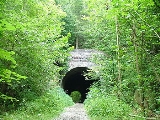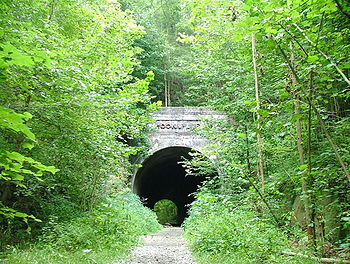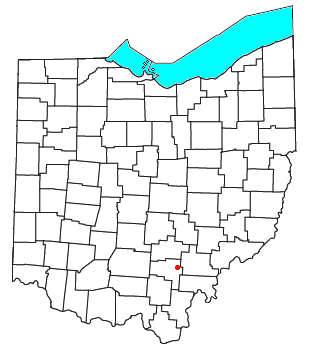
Moonville, Ohio
Encyclopedia


Ghost town
A ghost town is an abandoned town or city. A town often becomes a ghost town because the economic activity that supported it has failed, or due to natural or human-caused disasters such as floods, government actions, uncontrolled lawlessness, war, or nuclear disasters...
in southeastern Brown Township
Brown Township, Vinton County, Ohio
Brown Township is one of the twelve townships of Vinton County, Ohio, United States. The 2000 census found 281 people in the township.-Geography:Located in the northeastern corner of the county, it borders the following townships:...
, Vinton County
Vinton County, Ohio
Vinton County is a county located in the state of Ohio, United States. As of the 2010 census, the population was 13,435. , the least populous in the state. Its county seat is McArthur. The county is named for Samuel Finley Vinton, a 19th-century United States Congressman from...
, Ohio
Ohio
Ohio is a Midwestern state in the United States. The 34th largest state by area in the U.S.,it is the 7th‑most populous with over 11.5 million residents, containing several major American cities and seven metropolitan areas with populations of 500,000 or more.The state's capital is Columbus...
, United States
United States
The United States of America is a federal constitutional republic comprising fifty states and a federal district...
. Little remains of this former mining community except a few foundations, a cemetery, and an abandoned railroad tunnel
Tunnel
A tunnel is an underground passageway, completely enclosed except for openings for egress, commonly at each end.A tunnel may be for foot or vehicular road traffic, for rail traffic, or for a canal. Some tunnels are aqueducts to supply water for consumption or for hydroelectric stations or are sewers...
which is the subject of numerous ghost stories
Ghost story
A ghost story may be any piece of fiction, or drama, or an account of an experience, that includes a ghost, or simply takes as a premise the possibility of ghosts or characters' belief in them. Colloquially, the term can refer to any kind of scary story. In a narrower sense, the ghost story has...
.
History
In 1856, the Marietta and Cincinnati RailroadMarietta and Cincinnati Railroad
The Marietta and Cincinnati Railroad is a defunct railroad of southern Ohio that was later absorbed by the Baltimore and Ohio Railroad ....
(M&C) was pushing through southeastern Ohio to reach Cincinnati. William Cutler, the owner of the fledgling railroad, was having financial problems and was looking to streamline and conserve money while building the railroad.
A man named Samuel Coe
Samuel Coe
Samuel Coe was an English cricketer. He was a left-hand batsman and left-arm slow-medium bowler who played for Leicestershire....
convinced Cutler to build the railroad on his large property for free, in exchange for a favor. The railroad would be routed through Coe's land in order to haul coal and clay off of his property. This move saved the railroad a great deal by reducing the amount of distance to Cincinnati.
Several coal mines sprang up, and it was found that there was a rich supply of it in the immediate area. Soon the mining town of Moonville was born.
Moonville never was a big town, with a peak population in the 1870s of a little over a hundred. It is thought to be named for a man named Moon who once operated a store in the town. The town was isolated in the woods and far away from any other towns; people had to walk the tracks to get from there to the nearest towns of Hope or Mineral. Vinton County is currently the least populated and most heavily forested county in Ohio; in those days it was even more wild and inhospitable.
Walking the tracks was incredibly dangerous, and was made even more hazardous by two long trestle
Trestle
A trestle is a rigid frame used as a support, especially referring to a bridge composed of a number of short spans supported by such frames. In the context of trestle bridges, each supporting frame is generally referred to as a bent...
s in the area and the long Moonville tunnel. One trestle stood over Raccoon Creek
Raccoon Creek
Raccoon Creek may refer to:*Raccoon Creek, a tributary of the Coosa River in Alabama*Raccoon Creek , a tributary of the Etowah River*Raccoon Creek, a tributary of the Elm River...
less than 50 yards (45.7 m) away from the tunnel mouth. It is estimated that by 1920 alone, 5 or 6 people lost their lives on the bridges or within the tunnel. The last fatality was in 1986, when a 10 year old girl was struck by a CSX locomotive on that trestle directly in front of the tunnel.
In 1887 the M&C was bought out by the Baltimore and Ohio Railroad
Baltimore and Ohio Railroad
The Baltimore and Ohio Railroad was one of the oldest railroads in the United States and the first common carrier railroad. It came into being mostly because the city of Baltimore wanted to compete with the newly constructed Erie Canal and another canal being proposed by Pennsylvania, which...
(B&O). It quickly became part of a vital line from St. Louis
St. Louis, Missouri
St. Louis is an independent city on the eastern border of Missouri, United States. With a population of 319,294, it was the 58th-largest U.S. city at the 2010 U.S. Census. The Greater St...
to Washington, DC. Train traffic increased dramatically, while the town entered a decline from which it never recovered. By the turn of the century the coal mines slowly started to be used up and closed down. The last family left town in 1947; by then the town itself was abandoned. By the 1960s all the buildings were gone and there was little to mark the site, other than the town cemetery and the tunnel.
The legends
Several different ghosts are said to haunt the tunnel. The more famous is the "headless conductor", who is said to appear headless, wearing a railroad uniform, and carrying a lantern. Various reports claim that a railroad worker was killed near the tunnel. One popular account claims that a conductor was having an affair with an engineer's wife. The jealous engineer stopped the train and asked the conductor to check a brake line in the undercarriage. When the engineer saw that the conductor was under the train, he goosed the throttle, lurching the train forward and killing him. A less romanticized version is that of a brakeman falling from the train, a fairly common accident at the time. Sightings of this ghost date back to the 1890s.Another ghost is thought to be that of a miner who was struck by a train in the 1920s. The story is that he was heading home through the tunnel after a long night of drinking moonshine and playing poker. When a train approached he waved a lantern in a futile attempt to get it to stop. This ghost is described as a very tall black man wearing miner's garb and carrying a lantern. According to at least one account, the ghost is that of Rastus Dexter.
Another version of this story claims that the town of Moonville was in the grip of a smallpox
Smallpox
Smallpox was an infectious disease unique to humans, caused by either of two virus variants, Variola major and Variola minor. The disease is also known by the Latin names Variola or Variola vera, which is a derivative of the Latin varius, meaning "spotted", or varus, meaning "pimple"...
plague and the town was in dire need of supplies. The ghost was that of a man who tried to save the town by heroically attempting to wave down a passing train that was ordered not to stop at the quarantined town. Unfortunately he couldn't stop the train and was run over, and the town succumbed to smallpox. This story is purely based in myth and never occurred.
A third ghost is said to have appeared to hikers, a middle-aged woman dressed in white. She is thought to be the spirit of a woman killed on the trestle in 1905.
There are two other noted fatalities that took place around the tunnel that are worth mentioning:
One had to do with a man who became embroiled in a conflict at a local saloon. He apparently was followed home along the tracks and bushwhacked by his attackers, then left to die on the tracks very close to the tunnel. He was found in the morning run over by several trains.
Probably the most bizarre story is a freak accident that cost yet another young man his life. The man (Charles Ferguson http://www.forgottenoh.com/moonville.html) in his late 20s waited patiently for a train to pass before crossing the tracks. He preceded to cross only to be hit by the second half of the train which had somehow become uncoupled from the first half. This took place between the trestle bridge and the tunnel.
The demise of the line
With the town long gone, the train traffic continued to increase on the single track line. In 1973 the B&O merged with the Chesapeake and Ohio RailwayChesapeake and Ohio Railway
The Chesapeake and Ohio Railway was a Class I railroad formed in 1869 in Virginia from several smaller Virginia railroads begun in the 19th century. Led by industrialist Collis P...
(C&O) and the Western Maryland Railway
Western Maryland Railway
The Western Maryland Railway was an American Class I railroad which operated in Maryland, West Virginia, and Pennsylvania. It was primarily a coal hauling and freight railroad, with a small passenger train operation. The WM became part of the Chessie System in 1973 and ceased operating its lines...
(WM) to form the Chessie System
Chessie System
Chessie System, Inc. was a holding company that owned the Chesapeake and Ohio Railway , the Baltimore and Ohio Railroad , the Western Maryland Railway , and several smaller carriers. It was incorporated in Virginia on February 26, 1973, and it acquired the C&O on June 15...
. Train traffic doubled, with as many as 14 trains per day.
Railroad workers called the line the most lonesome, desolate eight miles (13 km) of track between Parkersburg, West Virginia
Parkersburg, West Virginia
As of the census of 2000, there were 33,099 people, 14,467 households, and 8,767 families residing in the city. In 2006 the U.S. Census Bureau estimated that Parkersburg's population had decreased 4.4% to 31,755. The population density was 2,800.5 people per square mile . There were 16,100 housing...
and St. Louis. They hated the area because it was isolated and trains seemed to show up without warning. The line was "dark" (unsignaled) between Parkersburg and Cincinnati, and traffic was governed by train order
Train order
Train order operation, or more accurately Timetable and Train order operation, is a largely obsolete system by which the railroads of North America conveyed operating instructions before the days of centralized traffic control, direct traffic control, and the use of track warrants conveyed by radio...
s.
In 1981, a signal was erected at Moonville. The railroad said that if a railroad worker needed to stop a train, they had to use this signal, not a flashlight or lantern. Engineers and conductors were ordered not to go into emergency unless the signal was red. This measure was put in place specifically for this area because of the numerous ghost sightings involving the spirit said to be waving a lantern in an alarming fashion, that had forced many trains over the years into emergency.
In June 1985, CSX announced that the line between Cumberland, Maryland
Cumberland, Maryland
Cumberland is a city in the far western, Appalachian portion of Maryland, United States. It is the county seat of Allegany County, and the primary city of the Cumberland, MD-WV Metropolitan Statistical Area. At the 2010 census, the city had a population of 20,859, and the metropolitan area had a...
and Cincinnati would be reduced to secondary status, and the last scheduled freight train passed through Moonville in August. Trains continued to run until the line was abandoned and the rails pulled up in 1988. The area remains accessible and the old roadbed provides access to the tunnel. Plans to turn the area into a formal rail trail
Rail trail
A rail trail is the conversion of a disused railway easement into a multi-use path, typically for walking, cycling and sometimes horse riding. The characteristics of former tracks—flat, long, frequently running through historical areas—are appealing for various development. The term sometimes also...
, the Moonville Rail-Trail
Moonville Rail-Trail
right|thumb|King Switch TunnelThe Moonville Rail-Trail is a sixteen-mile rail-trail in southeast Ohio, located in Vinton and Athens Counties. It is largely embedded in the Zaleski State Forest and passes close to Lake Hope State Park...
, have been implemented. Six and a half miles of trail are currently open, with nine and a half miles, plus twelve bridges, still needed.

